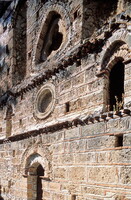Mystras: Peribleptos
unknown (Greek (modern))

Download1A3-B-G-M-9-B2_cp.jpg (838.8Kb)
Alternative Title
Peribleptos
Date
1350-1400Description
View of the remains south of the church, detail; This domed cross-in-square church (second half of the 14th century) lies at the south end of the Lower Town with a view eastwards. Its construction is distinctive as it is partly built into the rock. The main entrance lies beside the northernmost of the three pentagonal apses and leads through a low, narrow corridor into the church, beneath the north arm of the cross. The wall paintings are usually dated to the reign of Manuel Kantakouzenos, and their close stylistic affinity with the illustrations in a copy of the theological works of John VI Kantakouzenos (1370-1375; Paris, Bib. N., gr. 1242) may indicate a more precise date in the 1370s. Above the sanctuary is the Ascension; the central apse has a Virgin and Child with liturgical scenes and figures of bishops and saints on the adjacent walls. The central dome shows the Pantokrator, who is surrounded by prophets, the Hetoimasia, the Virgin and angels. Scenes from the Dodekaeorton, the Passion and the Life of the Virgin occupy the upper zones of the nave. The zone below has full-length saints, while on the west wall is the founding couple offering a model of the church to the Virgin. The lowest part of the walls is decorated with a painted dado imitating marble revetment. The iconography of the wall paintings emphasizes the liturgy and the Life of the Virgin, which is represented in 25 scenes, making it one of the richest of its kind in monumental painting. Source: Grove Art Online; http://www.oxfordartonline.com/ (accessed 7/17/2008)
Type of Work
churchSubject
architectural exteriors, cycles or series, Mary, Blessed Virgin, Saint, religious, Byzantine
Rights
Rights Statement
Licensed for educational and research use by the MIT community only